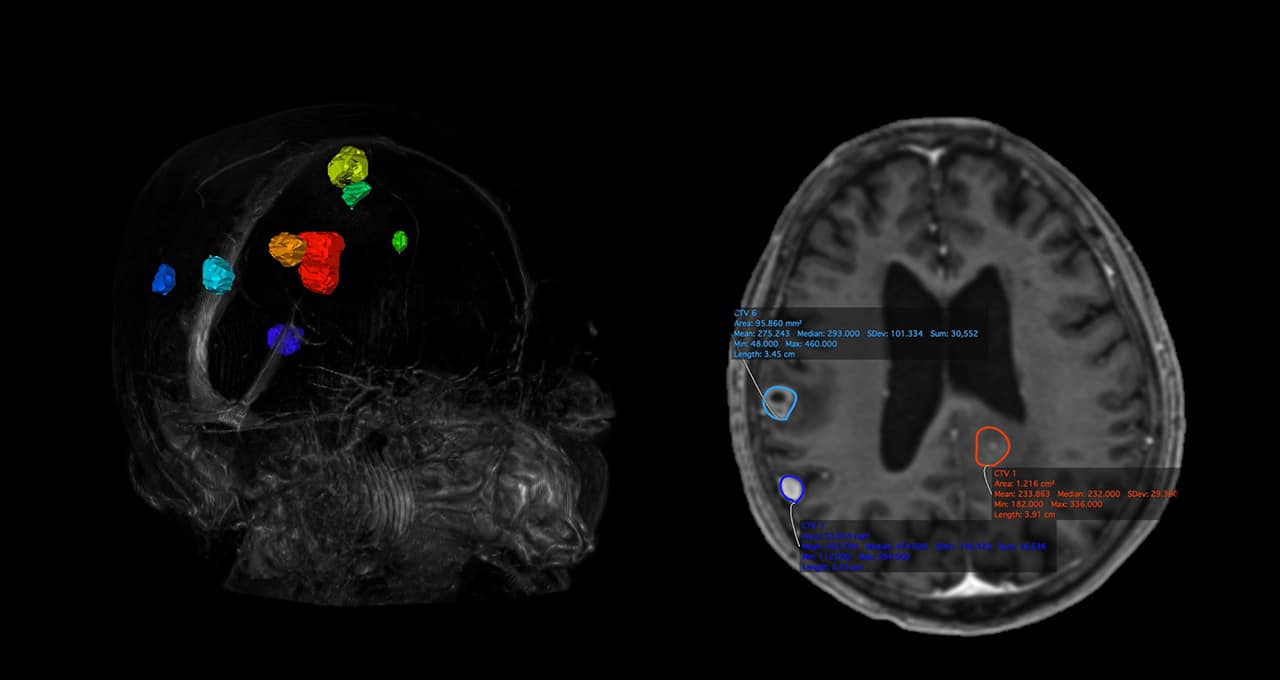Of the millions diagnosed with cancer each year, over half receive some form of radiation therapy.
Deep learning is helping radiation oncologists make the process more precise by automatically labeling tumors from medical scans in a process known as contouring.
It’s a delicate balance.
“If oncologists contour too small an area, then radiation doesn’t treat the whole tumor and it could keep growing,” said Jen-Tang Lu, founder and CEO of Vysioneer, a Boston-based startup with an office in Taiwan. “If they contour too much, then radiation can harm the neighboring normal tissues.”
A member of the NVIDIA Inception startup accelerator program, Vysioneer builds AI tools to automate the time-consuming process of tumor contouring. To ensure the efficacy and safety of radiotherapy, radiation oncologists can easily spend hours contouring tumors from medical scans, Lu said.
The company’s first product, VBrain, can identify the three most common types of brain tumors from CT and MRI scans. Trained on NVIDIA V100 Tensor Core GPUs in the cloud and NVIDIA Quadro RTX 8000 GPUs on premises, the tool can speed up the contouring task by more than 6x — from over an hour to less than 10 minutes.
Vysioneer showcased its latest demos in the NVIDIA booth at the annual meeting of the Radiological Society of North America last week in Chicago. It’s one of more than 50 NVIDIA Inception startups that attended the conference.
Targeting Metastatic Brain Tumors
A non-invasive treatment, precision radiation therapy uses a high dosage of X-ray beams to destroy tumors without harming neighboring tissues.
Due to the availability of public datasets, most AI models that identify brain cancer from medical scans focus on gliomas, which are primary tumors — ones that originate in the brain.
VBrain, trained on more than 1,500 proprietary CT and MRI scans, identifies the vastly more common metastatic type of brain tumors, which occur when cancer spreads to the brain from another part of the body. Metastatic brain tumors typically occur in multiple parts of the brain at once, and can be tiny and hard to spot from medical scans.
VBrain integrates seamlessly into radiation oncologists’ existing clinical workflow, processing scans in just seconds using an NVIDIA GPU for inference. The tool could reduce variability among radiation oncologists, Lu says, and can also identify tiny lesions that radiologists or clinicians might miss.
The company has deployed its solution in a clinical trial at National Taiwan University Hospital, running on an on-premises server of NVIDIA GPUs.
In one case at the hospital, a patient had lung cancer that spread to the brain. During diagnosis, the patient’s radiologist identified a single large lesion from the brain scan. But VBrain revealed another two tiny lesions. This additional information led the oncologists to alter the patient’s radiation treatment plan.
Vysioneer is working towards FDA clearance for VBrain and plans to launch contouring AI models for medical images of other parts of the body. The company also plans to make VBrain available on NGC, a container registry that provides startups with streamlined deployment, access to the GPU compute ecosystem and a robust distribution channel.
NVIDIA tests and optimizes healthcare AI applications, like VBrain, to operate with the NVIDIA EGX platform, which enables fleets of devices and multiple physical locations of edge nodes to be remotely managed easily and securely, meeting the needs of data security and real-time intelligence in hospitals.
NVIDIA Inception helps startups during critical stages of product development, prototyping and deployment. Every Inception member receives a custom set of ongoing benefits, such as NVIDIA Deep Learning Institute credits, go-to-market support and hardware technology discounts that enable startups with fundamental tools to help them grow.
Lu says the technical articles, newsletters and better access to GPUs have helped the company — founded just six months ago — to efficiently build out its AI solution.
Lu previously was a member of the MGH & BWH Center for Clinical Data Science, where he led the development of DeepSPINE, an AI system to automate spinal diagnosis, trained on an NVIDIA DGX-1 system.
Main image shows VBrain-generated 3D tumor rendering (left) and tumor contours (right) for radiation treatment planning.
